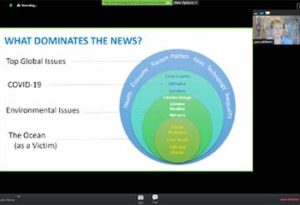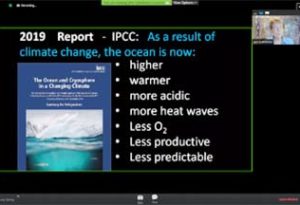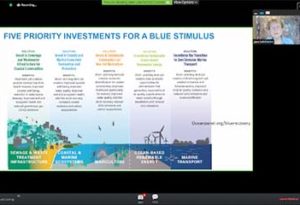Editor’s note: This is the 1st in a series of posts by environmental reporting students on things they learned at the recent Society of Environmental Journalists conference.
By Anne Hooper

Anne Hooper
If you’re anything like me, hearing the word “conference” stirs up anxiety. The thought of being surrounded by experts as they converse in industry jargon is intimidating—especially when you’re there to get a scoop.
With a few tips and tricks, however, you can take intimidation out of the equation.
 I attended the recent Society of Environmental Journalists online workshop, “Oceans, Coasts, and the 2020 Election,” which was led by former National Oceanic and Atmospheric Administration administrator Jane Lubchenco and featured panelists Robert McClure and Virginia Gewin, both journalists.
I attended the recent Society of Environmental Journalists online workshop, “Oceans, Coasts, and the 2020 Election,” which was led by former National Oceanic and Atmospheric Administration administrator Jane Lubchenco and featured panelists Robert McClure and Virginia Gewin, both journalists.
Here’s some of what I learned:
Focusing on Key Quotes
The entire purpose of attending an industry conference is to hear what experts in that field have to say. One way to maximize this experience is to collect as many quotes as possible. You won’t be able to record every single word a speaker says—and that’s perfectly fine. The best quotes to capture are those introducing, outlining, or summarizing a topic. Here are some examples from Lubchenco at the “Oceans” workshop:
- “Science enables durable success in policy and action.”
- “I say the ocean rather than oceans because it’s all one system — the ocean connects us all.”
- “Our current narrative is to see the ocean as a victim. Instead, we need to view it as a solution.”
Quotes can summarize or explain complex topics. They can also provide unique insights from experts.
Photo Opportunities
Whether it’s a chart, infographic or a compelling photo, visuals are an integral part of storytelling. Along with helping prevent monotonous narration, pictures help the audience to visualize different aspects of the story.
Here are several informative graphics taken from the “Oceans” workshop:

(Lubchenco, 2020)

(Lubchenco, 2020)

(Lubchenco, 2020)
And, of course, properly attribute cite any images included in your story.
Find Facts and Figures
In a story, numbers are eye-catching and impactful — they stand out among a sea of words. Pay extra attention to any numerical figures, such as percentages, that the speaker mentions.
Some examples from Lubchenco:
- “Every $1 invested in a sustainable ocean economy can yield $5 in benefits.”
- “The Ocean Panel is an organization consisting of world leaders from 14 countries that represent 30% of the world’s coastline population.”
Were your eyes immediately drawn to the numbers in this section? If so, you’re certainly not alone. Numerals draw our attention. On top of that, they allow readers to mentally quantify the situation.
For example, merely stating that “putting money into ocean industries yields much more money than is initially invested” is vague and not very compelling. The $1-to-$5 investment figure, however, is much more specific—and it’s easy to conceptualize such a ratio.
Be Specific
Covering current events can be overwhelming, especially when there are multiple angles from which you can approach the story. This is something I certainly experienced at the “Oceans, Coasts” workshop. With the session covering a diverse range of topics—which included environmental sustainability, political policy and economics—I experienced a bit of information overload. However, when I decided to turn my focus to the monetary aspect of the story, I found it easier to home in on important facts.
Get Active
Don’t be afraid to engage with people or ask questions.! At worst, someone may brush you off, respond rudely, or refuse to answer a question. At best, however, you could find an important contact that provides you with crucial information.
Anne Hooper, a master’s student in MSU’s Health and Risk Communication Program, is enrolled in the Knight Center’s Environmental Reporting class.
